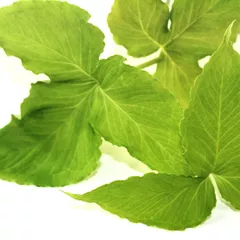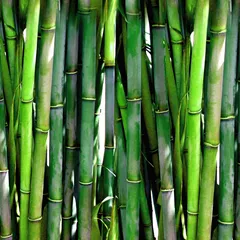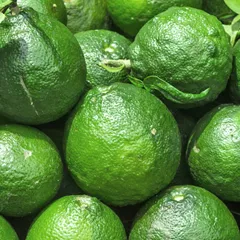Jin Fei Cao San
Chinese: 金沸草散
Pinyin: Jīn fèi cǎo sàn
Other names: Inula Powder








Jin Fei Cao San
Chinese: 金沸草散
Pinyin: Jīn fèi cǎo sàn
Other names: Inula Powder
Ingredients: 9 herbs
Category: Formulas that clear Wind-Cold
- Disperses Wind-Cold
- Descends Lung Qi
- Transform Phlegm
- Stop cough and calms wheezing
Source: Formulary of the Pharmacy Service for Benefiting the People in the Taiping Era (1107 AD )
The information provided here is not a replacement for a doctor. You shouldn't use it for the purpose of self-diagnosing or self-medicating but rather so you can have a more informed discussion with a professional TCM practitioner.
Jin Fei Cao San is a 9-ingredient Chinese Medicine formula with Inula Flowers (Xuan Fu Hua) and Ephedra (Ma Huang) as principal ingredients.
Invented in 1107 AD, it belongs to the category of formulas that clear Wind-Cold. Its main actions are: 1) disperses Wind-Cold and 2) descends Lung Qi.
In Chinese Medicine health conditions are thought to arise due to "disharmonies" in the body as a system. These disharmonies are called "patterns" and the very purpose of herbal formulas is to fight them in order to restore the body's harmony.
In this case Jin Fei Cao San is used by TCM practitioners to fight patterns like Wind-Cold or Rebellious Lung Qi. From a Western Medicine standpoint, such patterns can give rise to a range of conditions such as common cold, influenza or wheezing for instance.
On this page, after a detailed description of each of the nine ingredients in Jin Fei Cao San, we review the patterns and conditions that Jin Fei Cao San helps treat.
The nine ingredients in Jin Fei Cao San

Xuan Fu Hua is a king ingredient in Jin Fei Cao San. Like the name indicates, it means it has more power than other ingredients in the formula.
1. Inula Flowers (Xuan Fu Hua)
Xuan Fu Hua assists the Lung Qi to flow smoothly and descend properly, so as to relieve the cough and wheezing. This herb disperses the Wind-Cold Evils and Phlegm by directing the Qi downward. As a result, it treats the Exterior Wind-Cold and Interior Phlegm accumulation.

Ma Huang is a king ingredient in Jin Fei Cao San. Like the name indicates, it means it has more power than other ingredients in the formula.
2. Ephedra (Ma Huang)
Ma Huang assists the Lung Qi to flow smoothly and descend properly, so as to relieve the cough and wheezing. This herb disperses the Wind-Cold Evils and Phlegm by directing the Qi downward. As a result, it treats the Exterior Wind-Cold and Interior Phlegm accumulation.

Jing Jie is a deputy ingredient in Jin Fei Cao San. This means it helps the king ingredient(s) treat the main pattern or it serves to treat a coexisting pattern.
3. Japanese Catnip (Jing Jie)
Part used: Aerial portion and flowers, or the spikes only (in which case it is called Jing Jie Sui)
Nature: Neutral
Taste(s): Pungent
In general Jing Jie's main actions are as follows: "Relieves the Exterior and disperses Cold or Heat depending on the other herbs used. Releases the Exterior for measles. Stops bleeding. Abates swellings."
In the context of Jin Fei Cao San, it is used because it helps the key herbs to release the Wind-Cold Evil from the Exterior.
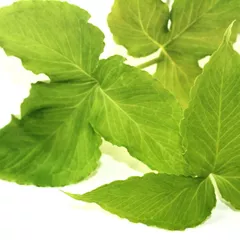
Ban Xia is an assistant ingredient in Jin Fei Cao San. This means that it either serves to reinforces the effect of other ingredients or it moderates their toxicity.
4. Crow-Dipper Rhizomes (Ban Xia)
Part used: Dried rhizome and tuber
Nature: Warm
Taste(s): Pungent
In general Ban Xia's main actions are as follows: "Drains Dampness and reduces Phlegm. Reverses the flow of Rebellious Qi. Reduces hardenings and relieves distention."
In the context of Jin Fei Cao San, it is used because it transforms Phlegm, dries Dampness, descends Qi and relieves the cough.

Qian Hu is an assistant ingredient in Jin Fei Cao San. This means that it either serves to reinforces the effect of other ingredients or it moderates their toxicity.
5. Hogfennel Roots (Qian Hu)
Part used: Dried root and rhizome
Nature: Cool
In general Qian Hu's main actions are as follows: "Directs the ascending flow of Lung Qi downward to stop cough. Expels Phlegm. Expels Wind and relieves the Exterior for Wind-Heat."
In the context of Jin Fei Cao San, it is used because it spreads the Lung Qi, removes Phlegm, relieves the cough, and descends Qi.

Chi Shao is an assistant ingredient in Jin Fei Cao San. This means that it either serves to reinforces the effect of other ingredients or it moderates their toxicity.
6. Red Peony Roots (Chi Shao)
Part used: Dried root
Nature: Cool
Taste(s): Bitter
Meridian affinity: Liver
Category: Herbs that invigorate the Blood
Chi Shao cools the Blood and clears Heat. Together with Jujube dates (Da Zao), it nourishes and cools the Yin and nutritive levels according to the Four Level Theory. As a result, it protect them from the acrid and warm effect of the other herbs of the formula as well as the Wind-Heat Evils. It also clears Heat caused by Wind-Cold Stagnation in Channels.
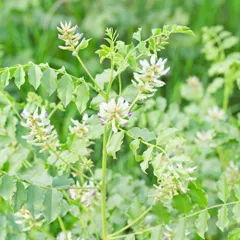
Gan Cao is an envoy ingredient in Jin Fei Cao San. This means that it directs the formula towards certain area of the body and/or harmonizes the actions of other ingredients.
7. Liquorice (Gan Cao)
Part used: Dried root and rhizome
Nature: Neutral
Taste(s): Sweet
Meridian affinity: HeartLungSpleenStomach
Category: Tonic herbs for Qi Deficiency
Gan Cao harmonizes the Middle Burner, strengthens Qi, and harmonizes the various actions of the herbs in the formula.

Sheng Jiang is an envoy ingredient in Jin Fei Cao San. This means that it directs the formula towards certain area of the body and/or harmonizes the actions of other ingredients.
8. Fresh Ginger (Sheng Jiang)
Sheng Jiang harmonize the Nutritive and Protective levels of the Four Level Theory. It also assists Ephedra (Ma Huang) and Japanese catnip (Jing Jie) in releasing Wind-Cold from the Exterior.

Da Zao is an envoy ingredient in Jin Fei Cao San. This means that it directs the formula towards certain area of the body and/or harmonizes the actions of other ingredients.
9. Jujube Dates (Da Zao)
Part used: Dried ripe fruit
Nature: Warm
Taste(s): Sweet
Meridian affinity: SpleenStomach
Category: Tonic herbs for Qi Deficiency
In general Da Zao's main actions are as follows: "Tonifies the Spleen and Stomach Qi. Tonifies the Blood. Calms the Shen (spirit). Moderates the actions of other herbs in formula."
In the context of Jin Fei Cao San, it is used because it harmonize the Nutritive and Protective levels of the Four Level Theory.
Conditions and patterns for which Jin Fei Cao San may be prescribed
It's important to remember that herbal formulas are meant to treat patterns, not "diseases" as understood in Western Medicine. According to Chinese Medicine patterns, which are disruptions to the body as a system, are the underlying root cause for diseases and conditions.
As such Jin Fei Cao San is used by TCM practitioners to treat two different patterns which we describe below.
But before we delve into these patterns here is an overview of the Western conditions they're commonly associated with:
Common cold Influenza Wheezing Asthma Acute bronchitis
Again it wouldn't be correct to say "Jin Fei Cao San treats common cold" for instance. Rather, Jin Fei Cao San is used to treat patterns that are sometimes the root cause behind common cold.
Now let's look at the two patterns commonly treated with Jin Fei Cao San.

'Cold' as a body pattern in Chinese Medicine is one of the so-called "Eight Principles". Learn more about Cold pattern in Chinese Medicine
Wind-Cold
Pulse type(s): Tight (Jin), Floating (Fu)
Symptoms: Fever Chills Sneezing Coughing No sweat Headaches No thirst Runny nose Body aches Sore throat Blocked nose Itchy throat Aversion to cold White watery mucus Occipital headaches Occipital stiffness
Jin Fei Cao San is sometimes prescribed by TCM practitioners to treat Wind-Cold. This pattern leads to symptoms such as aversion to cold, fever, sneezing and coughing. Patients with Wind-Cold typically exhibit tight (Jin) or floating (Fu) pulses.
This pattern is similar to Wind-Heat, but the Wind is combined with Cold rather than Heat. The shared symptoms are aversion to cold, sneezing, coughing, runny nose (with different mucus color), fever, occipital stiffness and ache. The different symptoms are the white watery mucus, no thirst, no... read more about Wind-Cold

The Lungs is a so-called "Zang" Organ. Learn more about the Lungs in Chinese Medicine
Rebellious Lung Qi
Jin Fei Cao San is sometimes prescribed by TCM practitioners to treat Rebellious Lung Qi. This pattern leads to symptoms such as coughing, asthma, nausea and vomiting.
The rebellious Lung Qi goes upwards instead of descending, thus the typical symptoms of coughing, asthma, chest oppression and distension.
When the pattern is caused by rebellions Liver Qi, typical symptoms are headache, dizziness and faint.
Rebellious Qi from the Stomach can also lead to this... read more about Rebellious Lung Qi
Formulas similar to Jin Fei Cao San
Xuan Fu Dai Zhe Tang is 56% similar to Jin Fei Cao San
Xing Su San is 45% similar to Jin Fei Cao San
Ban Xia Bai Zhu Tian Ma Tang is 44% similar to Jin Fei Cao San
Wen Dan Tang is 44% similar to Jin Fei Cao San
Xiao Chai Hu Tang is 44% similar to Jin Fei Cao San
Da Qing Long Tang is 44% similar to Jin Fei Cao San



